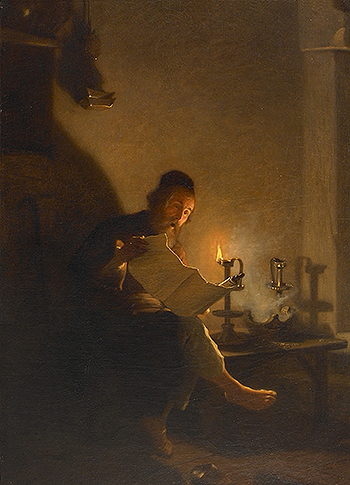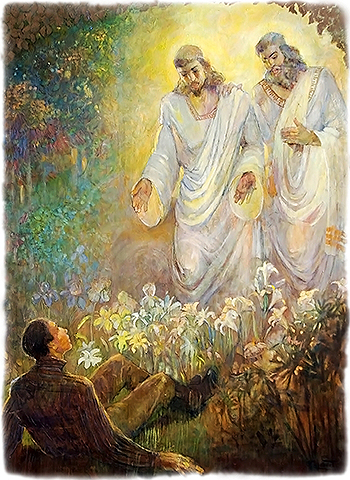Bicentennial Anniversary of First Vision Anchors BYU Exhibit of Connecting with the Divine
Contributed By Jason Swensen, Church News staff writer

The announcement of the Incarnation by the angel Gabriel to Mary is depicted in the Beatrice Parsons oil “Annunciation.” The painting is one of dozens works of art that will form the “Rend the Heavens” exhibition at BYU’s Museum of Art. Photo courtesy of the Brigham Young University Museum of Art.
Article Highlights
- “Rend the Heavens” opens September 13 and will run through January of 2022.
- The art exhibit captures moments where “our mortal experience intersects with eternity.”
“Oh that thou wouldest rend the heavens, that thou wouldest come down, that the mountains might flow down at thy presence.” —Isaiah 64:1
PROVO, Utah
In 2020, Latter-day Saints across the globe will commemorate one of the most essential bicentennials in world history.
Next spring marks the 200th anniversary of the First Vision. God the Father and Jesus Christ’s joint appearance to the 14-year-old Joseph Smith in a grove in Manchester, New York, signaled both the beginning of the restoration of Christ’s Church and the young Joseph’s prophetic duties on earth.
For believers, the First Vision also serves as a reminder that mortals continue to have direct and personal access to the divine. No barrier—be it physical or spiritual—stands between men and women and their Creator and His sacred messengers.
Brigham Young University’s Museum of Art (MOA) will celebrate next year’s bicentennial with a new exhibition entitled “Rend the Heavens: Intersections of the Human and the Divine.” It will be displayed for more than two years and include dozens of paintings, sculptures, photographs, and prints from the MOA’s vast collection, including several never-seen-before pieces.
Some of the artwork stretch back to the 1500s—evidence of the ageless impulse to discover communion between God and His children.

The Book of Esther’s vigilant Mordecai is depicted in “Mordecai, Second in Power to the King” by Jean Jules Antoine LeComte de Noüy. The oil is included in BYU’s “Rend the Heavens” exhibition. Photo courtesy of the Brigham Young University Museum of Art.

Franz Ittenbach’s “Mater Christi” captures the intimate connection between the divine and mortals through the Baby Jesus and His mother, Mary. Photo courtesy of the Brigham Young University Museum of Art.

Latter-day Saint artist Minerva Teichert’s “The First Vision” (1934) depicts a key moment of the Restoration. Photo courtesy of the Brigham Young University Museum of Art.
Curator Ashlee Whitaker said she’s long been interested in developing an exhibition that captures moments where “our mortal experience intersects with eternity.”
It’s a common human experience, she added, to feel a link “to something greater.” The 200th anniversary of the First Vision offers the perfect moment to utilize art in exploring sacred links between individuals and the heavens.
“Rend the Heavens” will obviously include depictions of the First Vision. But curators are also using that monumental theophany as a springboard to search for ways that people continue to connect with the divine.
Located in a basement gallery, the free exhibition consists of four sections.
The first section examines divine design and moments from scripture where mortals, such as the Bible’s Queen Esther, were placed by God in positions to bless others.
Another section celebrates Christ’s role as our Mediator and His redeeming relationship to His brothers and sisters. For many, said Whitaker, “the pinnacle intersection between the divine and the mundane or worldly was when Christ was God-made-flesh.”
A third element of the exhibition includes artwork that may not appear overtly religious at first glance. “But they speak to life’s experiences and how there are pivotal moments in our lives where we feel like there is a higher power,” said Whitaker.
Life-changing moments such as the birth of a child, the death of a loved one or, perhaps, a Job-like struggle against adversity often split veils between heaven and earth and trigger sustaining powers not easily explained.
The final section examines how worship brings a person into communion with God. “There is great diversity in the mix and a lot to think about,” said Whitaker.
Religious-themed exhibitions at the BYU-MOA always draw a wide audience—including students, art historians, Primary classes, young adult groups, and individuals who might not typically spend an hour or two in an art museum. Whitaker hopes each visitor walks away from “Rend the Heavens” with a heightened awareness of his or her own personal connection to a higher power.
“We hope our patrons will leave this exhibition feeling they’ve seen remarkable, thought-provoking art and that helped them to slow down, to reflect, and to feel something deeper—to connect with centuries of human experience and expression.”
“Rend the Heavens” opens September 13 and will run through January of 2022.

The mortal Christ is depicted in Rembrandt’s “Head of Christ,” an oil from the 17th Century. A key element of BYU’s “Rend the Heavens” is Christ’s mortal ministry that culminated with His Atonement. Photo courtesy of the Brigham Young University Museum of Art.

Several works of art in the BYU-MOA exhibition “Rend the Heavens” explores the presence of God during the trials of mortality—including death, as depicted in Maynard Dixon’s oil “Sketch for Campo Santo.” Photo courtesy of the Brigham Young University Museum of Art.

Maynard Dixon’s oil “Christmas Eve Procession” is a reminder of the human impulse to connect with the divine, including traditional celebrations of Christ’s birth. Photo courtesy of the Brigham Young University Museum of Art.
